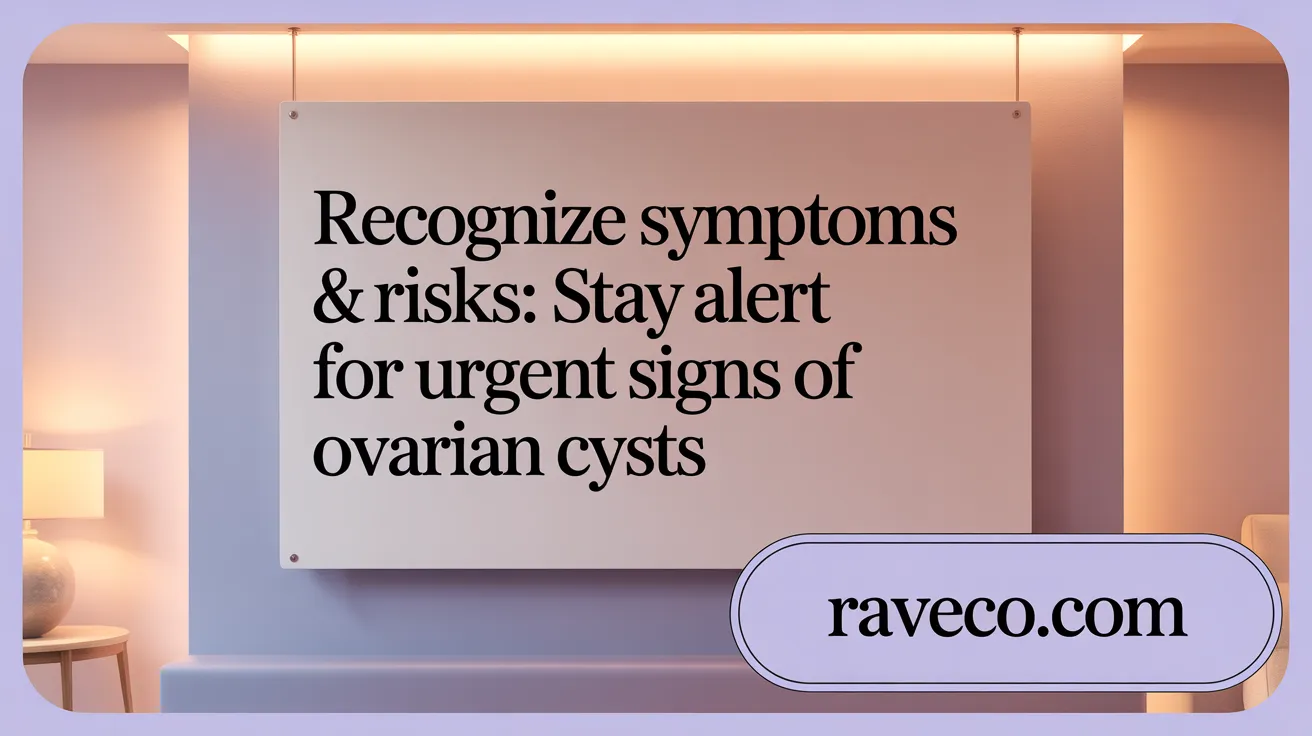Real Voices, Real Choices: Women Share Their Birth Control Journeys

Understanding Ovarian Cysts and Their Prevalence
What Are Ovarian Cysts?
Ovarian cysts are fluid-filled sacs that develop on or inside the ovaries. These sacs are often small and can form naturally as part of the menstrual cycle.
How Common Are Ovarian Cysts?
Ovarian cysts are very common, especially in women who are still in their reproductive years before menopause. It is estimated that up to 20% of women may develop at least one cyst during their lifetime.
Types of Ovarian Cysts
There are several types of ovarian cysts, including:
- Functional cysts: The most common type, which arises during the menstrual cycle, such as follicular cysts and corpus luteum cysts.
- Dermoid cysts: Contain various tissue types.
- Cystadenomas: Develop from ovarian tissue.
- Endometriomas: Linked to endometriosis.
- Malignant cysts: Rare and associated more often with postmenopausal women.
Benign Nature and Resolution
Most ovarian cysts are benign, meaning they are not cancerous. Functional cysts in particular typically resolve spontaneously within 6 to 8 weeks without treatment, often causing no symptoms or problems. This natural resolution is common and expected, reducing the need for invasive interventions in many cases.
Women in Queens, NY, and beyond are advised to have regular pelvic exams for early detection and management if needed, but the majority of cysts are harmless and resolve by themselves.
Recognizing Symptoms and Risk Factors

What symptoms may indicate the presence of ovarian cysts and when should women seek urgent medical attention?
Ovarian cysts often develop without causing symptoms. When symptoms do occur, they can include pelvic pain or a feeling of fullness in the lower abdomen. Women may also experience pain during intercourse, irregular menstrual cycles, or urinary and bowel issues due to pressure from larger cysts.
Serious symptoms requiring immediate medical care include sudden, severe pelvic or abdominal pain, nausea, vomiting, fever, dizziness, or signs of shock such as cold clammy skin and rapid breathing. These symptoms may indicate urgent complications like cyst rupture or ovarian torsion, both gynecological emergencies needing prompt treatment.
What factors increase the risk of developing ovarian cysts?
Several factors raise the likelihood of ovarian cyst formation. Women of reproductive age, particularly those who have not yet undergone menopause, are more prone to cysts, especially functional types related to ovulation. Pregnancy can also influence cyst formation, as can a personal history of previous ovarian cysts.
Medical conditions such as endometriosis and polycystic ovary syndrome (PCOS) are associated with higher cyst risks. The use of fertility medications that stimulate ovulation is another contributing factor. Hormonal imbalances play a role as well.
In postmenopausal women, although ovarian cysts are less common, the risk for cysts with malignant potential increases with age. Hence, persistent or complex cysts in this group warrant careful evaluation and monitoring.
Diagnostic Approaches and Monitoring Strategies

How are ovarian cysts diagnosed and monitored over time?
Ovarian cysts are primarily diagnosed using pelvic exams and ultrasound imaging, especially transvaginal ultrasound. This imaging technique provides detailed views of the cyst's size, location, and characteristics such as whether it is simple or complex. Ultrasound features like cyst size, septations, solid areas, and blood flow help guide clinical decisions about management.
Additionally, blood tests including CA-125 are used to assess the risk of ovarian malignancy, particularly in postmenopausal women, as elevated CA-125 levels may suggest cancer but are not definitive.
Most ovarian cysts, especially simple cysts smaller than 5 to 10 centimeters in premenopausal women, are benign and often resolve on their own. These cysts are monitored conservatively using follow-up ultrasounds over several menstrual cycles, typically spanning 2 to 3 months, to ensure they shrink or disappear (watchful waiting approach for ovarian cysts).
In cases where cysts are complex, larger than 10 cm, persistent, or if malignancy is suspected, further evaluation and possibly surgical intervention of ovarian cysts may be necessary.
Regular follow-up imaging is particularly important for women in Queens, NY, to allow early detection of changes in cysts and timely treatment. Local healthcare providers offer comprehensive gynecologic exams and high-resolution ultrasound services to support ongoing monitoring, ensuring patient safety and effective management.
By combining pelvic exams, ultrasound imaging, and selective blood testing, clinicians tailor monitoring strategies to individual patient risks, optimizing outcomes while minimizing unnecessary interventions (Ovarian cyst diagnosis and monitoring).
When to Opt for Treatment: Medical and Surgical Interventions

When is treatment necessary for ovarian cysts, and what treatment options are available?
Ovarian cysts often resolve without intervention; however, treatment becomes necessary under certain circumstances. These include cysts larger than 10 centimeters, cysts that persist beyond a few menstrual cycles, cause significant symptoms such as pelvic pain or pressure, or show features suspicious for malignancy on imaging. For more details see Ovarian cysts overview and Managing ovarian cysts.
Indications for hormonal treatment
Hormonal contraceptives, such as birth control pills, may be prescribed to prevent the formation of new functional ovarian cysts by suppressing ovulation. It's important to note that these medications do not shrink existing cysts but are useful in reducing recurrence, particularly for women with recurrent cysts related to the menstrual cycle. Learn more about Hormonal contraceptives for ovarian cysts and Birth control pills and ovarian cysts.
Criteria for surgical intervention
Surgery is typically recommended when cysts are:
- Larger than 10 centimeters
- Persisting or growing over time
- Causing severe symptoms (e.g., pain, pressure on organs)
- Unequivocally complex or suspicious for cancer upon ultrasound evaluation
Prompt surgical intervention is also critical if complications such as ovarian torsion or cyst rupture occur. For more information see Surgical treatment of ovarian cysts and Ovarian torsion symptoms.
Types of surgery
Surgical options include:
- Laparoscopy: A minimally invasive surgery for ovarian cysts involving small incisions for cyst removal or ovary preservation, associated with shorter hospital stays and faster recovery.
- Laparotomy: An open surgery with a larger incision, reserved for very large, complex, or suspected malignant cysts requiring extensive evaluation.
More on Laparoscopy vs laparotomy for cyst removal and Surgical options for ovarian cysts.
Fertility preservation in premenopausal women
For women who have not reached menopause, surgical management prioritizes fertility preservation. Whenever possible, the cyst is removed while conserving the ovary to maintain reproductive potential. In some cases, only the cyst is excised (cystectomy), sparing ovarian tissue. Details about Fertility preservation in ovarian cyst treatment and Ovarian cysts in premenopausal women are available.
Management considerations for postmenopausal women
In postmenopausal women, the risk of ovarian cancer is higher, necessitating a more cautious approach. Surgical removal of cysts is often recommended regardless of size if malignancy is suspected. Sometimes, removal of both ovaries may be considered as they no longer produce eggs and to reduce cancer risk. Read more about Postmenopausal ovarian cyst malignancy risk and Ovarian cysts and cancer risk.
Regular follow-up including pelvic exams and ultrasounds plays a crucial role in monitoring cysts and guiding the need for treatment. Women in Queens, NY, have access to healthcare providers skilled in these assessments and interventions, ensuring personalized care tailored to individual needs. For local care providers, see Ovarian cysts in Queens NY and OB/GYN services in NYC.
Complications and Emergency Management

What complications can arise from ovarian cysts and how are they managed?
Ovarian cysts, although often benign and self-resolving, can sometimes lead to serious complications such as ovarian torsion and cyst rupture. Ovarian torsion occurs when a cyst causes the ovary to twist around the ligaments that hold it, cutting off its blood supply. This can lead to sudden, severe pelvic pain, nausea, vomiting, and may cause permanent ovarian damage if not treated swiftly. Cyst rupture involves the breaking of the cyst wall, releasing fluid or blood into the pelvic cavity and causing intense pain, internal bleeding, and sometimes signs of shock.
Both torsion and rupture require emergency medical care. Diagnosis often includes urgent pelvic ultrasound and clinical evaluation. Surgical intervention, typically laparoscopic cystectomy or detorsion, is usually necessary to restore blood flow or remove the cyst and control bleeding.
These emergencies can have significant consequences for fertility if ovarian tissue is damaged. Therefore, timely diagnosis and prompt treatment are essential to preserve ovarian function and reproductive potential. Awareness of sudden severe pain, dizziness, fever, or vomiting should prompt immediate medical attention.
Early management by gynecologic specialists in Queens, NY, with access to advanced imaging and minimally invasive surgery for ovarian cysts, optimizes outcomes and reduces complications.
Personalized Care and Access to Women’s Health Services in Queens, NY
How does access to specialized women's health care in Queens, NY support ovarian cyst management?
Women in Queens, NY, have access to specialized obstetrical and gynecological care tailored to meet their unique health needs. Local providers, including women-led teams, offer comprehensive services that encompass ovarian cyst diagnosis and treatment. These services use advanced diagnostic tools such as high-resolution transvaginal ultrasounds, enabling precise evaluation of cyst size, composition, and complexity to guide management effectively.
Minimally invasive surgical options, including laparoscopy, are available within Queens, providing patients with procedures that promote faster recovery, reduced pain, and fertility preservation when needed. This advanced care improves outcomes for women requiring surgical intervention for large or symptomatic cysts.
Furthermore, Queens providers emphasize integrated care across the stages of a woman's reproductive health, including prenatal, fertility, and oncological support. This holistic approach ensures continuity and personalized treatment plans that consider each woman's overall health and reproductive goals.
Cultural competence and accessibility are priorities in Queens, where diverse populations receive care in multiple languages and culturally sensitive settings. This fosters effective communication and trust, enabling women to seek timely evaluation and follow-up for ovarian cysts without barriers.
Overall, the specialized women's health services in Queens empower women with expert care, cutting-edge diagnostics, and comprehensive support for managing ovarian cysts and related health concerns efficiently and compassionately.
Optimizing Outcomes Through Vigilant Monitoring and Timely Treatment
Monitoring and Treatment Summary
Ovarian cysts, typically benign and often resolving without intervention, require thoughtful monitoring to ensure health and avoid complications. Small, simple cysts, especially in premenopausal women, usually resolve within a few menstrual cycles and are commonly managed with watchful waiting and periodic ultrasound scans. For cysts larger than 10 centimeters, persistent, symptomatic, or suspicious for malignancy, surgical options such as minimally invasive laparoscopy or laparotomy may be necessary. Hormonal therapies, like birth control pills, help prevent new functional cyst formation but do not shrink existing cysts. Early identification and treatment are crucial, especially for postmenopausal women who face higher cancer risks.
Importance of Regular Pelvic Exams and Symptom Awareness
Routine pelvic examinations and ultrasound screenings are imperative for early detection and appropriate management of ovarian cysts. Women are encouraged to monitor and promptly report symptoms such as persistent pelvic pain, abdominal fullness, pain during intercourse, irregular menstrual cycles, or sudden severe pain, which may indicate complications like cyst rupture or ovarian torsion requiring urgent care.
Personalized Care and Timely Consultation
Care for ovarian cysts must be tailored to individual patient profiles, factoring in age, cyst characteristics, symptoms, and fertility considerations. Collaborative care involving gynecologists, radiologists, and oncologists ensures a comprehensive approach. Women in Queens, NY, and elsewhere are advised to seek timely medical consultation for ovarian cyst concerns to facilitate early diagnosis, preserve fertility when possible, and minimize risks.





.png)